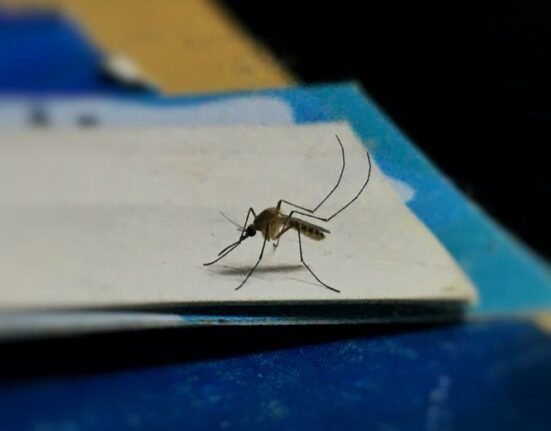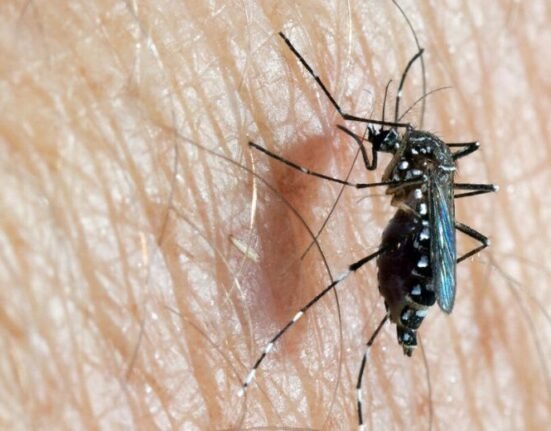HQ Team
April 6, 2023: Dengue viral infection has increased from 505,430 cases in 2000 to 5.2 million in 2019, and its spread among humans is increasing globally, the WHO stated.
The infection is caused by the virus DENV and transmitted to humans through the bite of infected mosquitoes. About half of the world’s population is at risk, with between 100 million and 400 million infections occurring yearly.
The American region reported 2.8 million cases and 1,280 deaths in 2022. “This increasing trend is continuing in 2023 where till the end of March 2023, 441,898 cases and 119 deaths have been reported,” according to an emailed statement.
The infection is more common in tropical and subtropical climates. Most people who get dengue won’t have symptoms. But for those that do, the most common symptoms are high fever, headache, body aches, nausea and rash.
Most of the infected people get better in a week or two. Some people develop severe dengue and need hospital care. In severe cases, dengue can be fatal.
Bites during day
The risk of the disease can be lowered by avoiding mosquito bites, especially during the day. Dengue is treated with pain medicine as there is no specific treatment.
“A high number of cases have been reported from Sudan 8,239 cases and 45 deaths since July 2022. It is rather early to get reports from Asia but trends are worrying,” according to the WHO statement released after the global agency’s experts met in Geneva.
Increased movement of people and goods, urbanization, and associated water and sanitation problems are contributing factors to the spread of the virus.
High precipitation, increased temperature and even water scarcity favour mosquitoes’ breeding. The virus and the vectors multiply faster at higher temperatures.
According to the statement, a few antivirals are under clinical trials, one vaccine is in the market, and two are under final phase three trial and review. The rollout of the Global Arbovirus Initiative is in progress.
Endemic in 100 nations
The Dengue disease is now endemic in more than 100 countries in the WHO Regions of Africa, the Americas, the Eastern Mediterranean, South-East Asia and the Western Pacific.
The Americas, South-East Asia and Western Pacific regions are the most seriously affected, with Asia representing around 70% of the global disease burden.
Dengue spreads to new areas, including Europe, and explosive outbreaks occur. Local transmission was reported for the first time in France and Croatia in 2010, and imported cases were detected in 3 other European countries.
The largest number of dengue cases ever reported globally was in 2019. All regions were affected, and dengue transmission was recorded in Afghanistan for the first time.
The American Region reported 3.1 million cases, with more than 25 000 classified as severe. A high number of cases were reported in Bangladesh (101 000), Malaysia (131 000), Philippines (420 000), and Vietnam (320 000) in Asia.
Dengue continues to affect Brazil, Colombia, the Cook Islands, Fiji, India, Kenya, Paraguay, Peru, the Philippines, the Reunion Islands and Vietnam as of 2021.
Another viral disease which resembles Dengue, Chikungunya, is a virus spread by Aedes mosquitoes and is endemic in East Africa and parts of Asia. Currently, 115 nations have reported CHIKV transmission.
The main disease burden is due to chronic disabilities and severe impact on the quality of life. The clinical manifestations vary by age, and newborns and the elderly are at greater risk for more severe disease.
Chikungunya outbreaks
Chikungunya outbreaks were reported from Paraguay, Argentina and Bolivia, and it is in high circulation in Brazil and other countries in the region.
“Atypical of this CHIKV outbreak are the reported cases of acute meningoencephalitis and neonatal mortality associated with the disease. Almost 70% of the deaths reported are in populations more than 60 years of age mostly with pre-existing conditions such as diabetes, hypertension and immunocompromised.”
Most CHIKV infections during pregnancy will not result in the virus being transmitted to the fetus. “Traveling has started again, so the risk of introduction and further spread in areas where these viruses have not circulated before and the mosquito is present is back.”
In 2022, WHO launched the Global Arbovirus Initiative, an integrated strategic plan to tackle emerging and re-emerging arboviruses.
Zika virus
Aedes mosquitoes, present on most continents, spread another virus called Zika. They bite mostly during the day. Zika can be transmitted sexually between people and from mother to child during pregnancy.
Zika virus disease has declined globally since 2017, but it still occurs at low levels in several countries in the Americas and other regions.
So far, in 2023, 3,000 people have been infected by the Zika virus in the region of the Americas, mostly from Brazil, Bolivia, Guatemala, Belize, and Colombia. “Zika emergence was eight years ago, which is enough time to accumulate susceptibility to build a new epidemic.”








